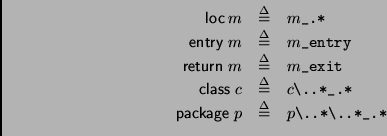
The Moped tool [8] can check a pushdown system, from an initial configuration, against an LTL formula where the atomic predicates consists of a set of atomic symbols that checks the identity of the top stack symbol or the control location (i.e., simply checks name equality). In case the LTL formula is falsified a reduced pushdown system constructed from the original one, that also falsifies the LTL formula, is presented as diagnostic information.
To represent the non-identity atomic
predicates (e.g.,
![]() )
as ``Moped LTL formulas'' a number of options
are possible.
Consider for instance the
)
as ``Moped LTL formulas'' a number of options
are possible.
Consider for instance the
![]() atomic predicate.
A direct representation of the predicate
in Moped LTL would consist of a disjunction over
all the program points in any class in the package.
atomic predicate.
A direct representation of the predicate
in Moped LTL would consist of a disjunction over
all the program points in any class in the package.
An alternative representation
strategy is to enrich the translation from
a call graph to a pushdown system.
Since Moped provides boolean variables
we could represent the current package identity
encoded in a set of boolean variables
in the pushdown system.
These variables would then
be updated for every rewrite rule
that crosses package boundaries. Finally
the representation of the
![]() predicate
itself would consist of a simple boolean condition.
predicate
itself would consist of a simple boolean condition.
We have instead opted to extend the Moped tool with atomic predicates that can match a control location, or the top stack symbol, against a regular expression. These predicates check the syntactic shape of the symbol being tested.
Consider the naming of
program points of a
method ![]() by the call graph construction.
Its entry program point will be named
by the call graph construction.
Its entry program point will be named
![]() ,
its (unique) return program point will be
named
,
its (unique) return program point will be
named
![]() ,
and all other program points in
,
and all other program points in ![]() are of the form
are of the form
![]() where
where ![]() is a natural number.
is a natural number.
With these conventions in place the atomic predicates can be represented in ``regular expression Moped'' as indicated below:

.'
has to be quoted using a backslash character
inside a regular expression to represent itself, rather
than representing any character.
So called wildcards can be used in a regular expression
to achieve a limited form of quantification over
program points. The static analysis tool,
for instance, gives the name
![]() to an object constructor method
to an object constructor method
![]() .
Thus, whether the current program point
is in any object constructor can be tested by
the regular expression predicate
.
Thus, whether the current program point
is in any object constructor can be tested by
the regular expression predicate
.*\..*\.<init>_.*.
As a further example,
the
![]() predicate,
which recognises control points inside an API function,
can be defined
predicate,
which recognises control points inside an API function,
can be defined
`(java\.lang|javacard\..*|javacardx\..*).*'.